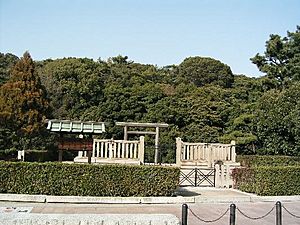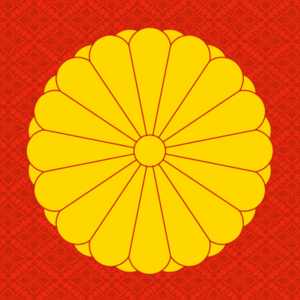Emperor Hanzei facts for kids
Quick facts for kids Hanzei |
|
|---|---|
| Emperor of Japan | |
| Reign | legendary |
| Predecessor | Richū |
| Successor | Ingyō |
| Born | legendary |
| Died | legendary |
| Burial | Mozu no Mimihara no naka no misasagi (Osaka) |
Emperor Hanzei (反正天皇, Hanzei-tennō) was the 18th emperor of Japan. He is part of the traditional order of succession.
Historians believe that many details about Emperor Hanzei's life are legends. However, they also think these stories are likely true. The name Hanzei-tennō was given to him after his death. This is called a posthumous name.
It is hard to know the exact dates for Emperor Hanzei's life or when he ruled. The names and order of these early emperors were officially confirmed much later. This happened during the time of Emperor Kammu, who was the 50th emperor.
Who Was Emperor Hanzei?
According to ancient Japanese books like Nihonshoki and Kojiki, Emperor Hanzei was a son of Emperor Nintoku. His older brother was Emperor Richū.
Hanzei became emperor even though Richū had two sons. This means he skipped over his nephews in the line of succession. Not many other details about his family life have survived.
His Time as Emperor
Very little is known about what happened during Emperor Hanzei's life and reign. There is not much information available about emperors before the 29th ruler, Emperor Kimmei.

Hanzei's time as emperor is described as a period of peace. He passed away quietly in his palace.
After His Death
His official name after his death, his posthumous name, was made official many centuries later. This was long after the time he was believed to have lived.
The Imperial Household Agency says that Emperor Hanzei's final resting place is in an tumulus (a large burial mound) in Sakai. This type of mound is called a kofun. Hanzei is honored at a special Shinto shrine (misasagi) that is connected to his burial mound.
Related pages
| Preceded by Emperor Richū |
Legendary Emperor of Japan Hanzei 406-410 (traditional dates) |
Succeeded by Emperor Ingyō |
See also
 In Spanish: Hanzei Tennō para niños
In Spanish: Hanzei Tennō para niños


